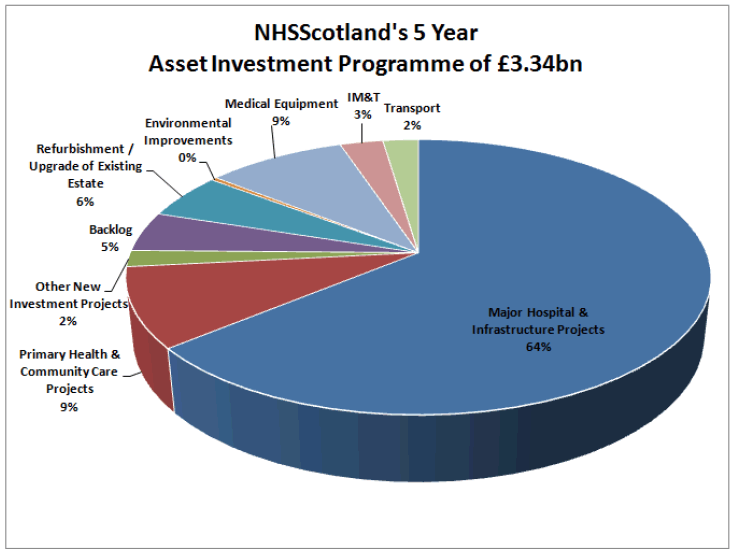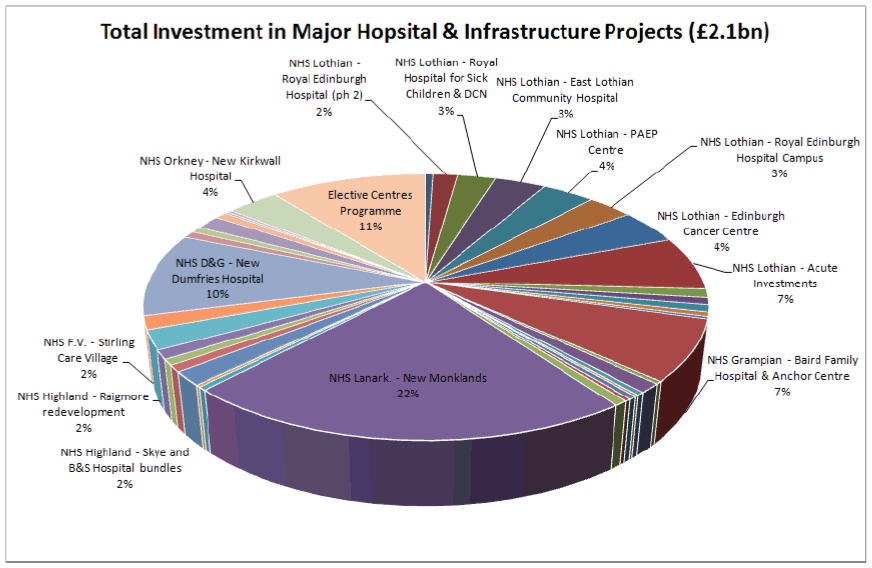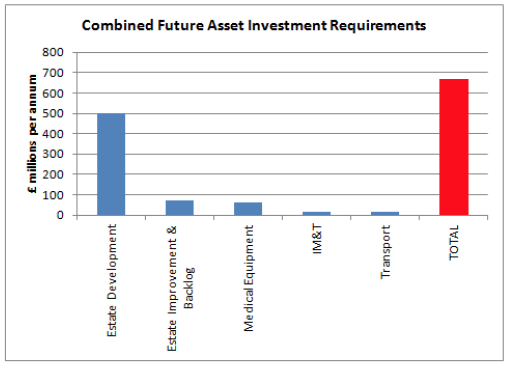NHS Scotland assets and facilities 2017: annual report
Seventh edition of the state of NHS Scotland assets and facilities report (SAFR).
4.0 Planned future investment in assets
NHS Boards are planning investments in their assets over the next 5+ years of circa £3.34bn (based on NHS Boards' 5+ year investment plans presented in their PAMS). While major parts of this programme of investments are subject to funding availability and approval, it does represent a significant opportunity to further improve the condition and performance of these assets and enable the disposal of older properties which are expected to generate receipts of over £160m over the same period (subject to economic and market conditions). It will also further enhance the important supporting role that assets play in the delivery of quality healthcare delivery and NHSScotland’s 2020 Vision.
This investment covers all asset types (property, medical equipment, IM&T, and fleet) and will be achieved through a combination of capital and revenue based investment. The following chart provides a breakdown of this investment.

4.1 Investment in Major Hospital & Infrastructure Projects
Investment in 'Major Hospital & Infrastructure Projects' accounts for 64% of the overall planned future investment described above and includes the key strategic investments planned by each NHS Board. They will be funded mainly though NHS Board capital or NPD / hub revenue based funding. The following chart provides a breakdown of the £2.1bn of investment associated with these major hospital and infrastructure projects.

Note: while all major projects have been included in the above chart only those which are over 1% of the total investment have been listed, for clarity of presentation reasons only. Also, as the business case process for planning the new Monklands project is at an early stage, an element of these projected costs may fall out of the current 5 year investment programme.
4.2 Investment in Primary and Community Care
In addition to the £2.1bn of investment on the major hospital & infrastructure projects / programmes described above (which includes some primary and community care hospital projects), a further £300 million is being planned for new primary & community care projects; including at least 25 primary care projects planned for the next 5 years across Glasgow, Lothians, Tayside, Fife, Grampian, Highland, Forth Valley, and the Borders. This investment is key in delivering the emerging Health and Social Care Integration agenda and shifting the balance of care from hospitals to local facilities and people’s homes.
4.3 Income receipts from asset disposals
A direct consequence of investment in new facilities can often be a surplus of older accommodation no longer required for operational purposes. Boards have identified in their PAMS planned disposals of these surplus properties which they report an income value of circa £160m over the next 5+ years. Scottish Futures Trust is actively supporting NHS Boards to maximise the potential of income receipts from these disposals.
The programme of anticipated income receipts per NHS Board over the next 5+ years are listed in the following table, but these are subject to change dependent upon economic and market conditions at the time of sale.
| NHS Board | Anticipated Future Income Receipts from Disposals (£m) |
|---|---|
| NHS Greater Glasgow & Clyde | 45 |
| NHS Lothian | 53 |
| NHS Tayside | 11 |
| NHS Grampian | 17 |
| NHS Fife | 6 |
| NHS Ayrshire & Arran | 2 |
| NHS Lanarkshire | 6 |
| NHS Highland | 3 |
| NHS Forth Valley | 9 |
| NHS Dumfries & Galloway | 1 |
| NHS National Services Scotland | 5 |
| Others | 2 |
| Total: | 160 |
4.4 Investment required on vehicle assets
As described earlier in this report, many of the NHSScotland vehicles are leased and, therefore, the replacement cost of these vehicles is effectively included within the annual leasing costs. However, substantial vehicle assets remain owned, particularly those of the Scottish Ambulance Service, NHS National Services Scotland, NHS Tayside, NHS Fife, and NHS Borders. The current 5 year investment plan for vehicle assets, which is taken from NHS Boards' own investment plans and includes the Scottish Ambulance Service’s vehicle replacement programme, is an average of circa £15m per annum. Earlier analysis of age profile suggests that there isn’t currently a backlog of investment need for these assets but funding levels will need to be maintained to continue to support this position.
4.5 Investment required on medical equipment assets
In relation to its overall £1bn replacement value, during 2016/17 a total of over £53m was invested in medical equipment. This would theoretically result in complete replacement of all existing equipment within 20 years. However, as a general planning rule most equipment should be replaced within a 10 - 15 year cycle; hence, the current investment level seems to be set below the minimum level with limited scope for investment in additional equipment. This appears to be a continuing trend of constrained investment in medical equipment replacement which is having to be carefully managed by extending the life of equipment whilst reducing any failure risks.
Note that annual investment in medical equipment can rise and fall as equipment replacement is grouped together to improve purchasing efficiencies, but also rapid technological developments in some equipment, including high cost radiotherapy, imaging and endoscopy equipment, which together account for approximately 30% of the total value of medical equipment, reduces the effective lifespan of this equipment to 7 to 10 years. The speed of change in technology over the last 10 years has added further pressure to upgrade equipment more regularly and to meet the additional cost of this technologically enabled equipment. There are also specific peaks in investment requirements often associated with earlier equipping programmes for new hospitals.
Accordingly, future investment in medical investment would need to double if it was to achieve an ideal position of a full replacement cycle of 10 years.
Further information is available in Annex C on medical equipment assets.
4.6 Investment required on IM&T assets
NHS Boards are reporting planned expenditure on IM&T projects of circa £100 million over the next 5 years, which is similar to that reported in last year’s SAFR. Further IM&T investment is also incorporated into some of the major investment projects associated with the refurbishment and replacement of property assets.
This expenditure is part of the overall eHealth Finance Strategy and, in addition, the Scottish Government’s eHealth Division retained funds may also be used to contribute to refresh activities in relation to infrastructure.
Careful management will be required to ensure that a build-up of infrastructure (network cabling, servers, etc.) backlog does not arise due to the increasing use of end user IM&T equipment, as well as the relatively short life of desktop and mobile equipment devices, which have the potential to outgrow the capacity of the infrastructure. This investment will also need to fund any additional investment in technology.
4.7 Summary of asset investment plans
The combined asset investment plans of circa £670 million per annum are shown in the chart below. Although presented as a single investment amount, in practice some of the capital requirement will be funded through revenue schemes such as NPD, hub and leasing arrangement.

In addition to the investment requirements identified above there is expected to be further investment required to implement the recommendations of the Shared Services and Soft FM reviews, and any environmental improvement investment projects.
Contact
There is a problem
Thanks for your feedback